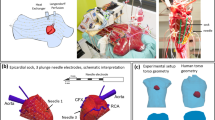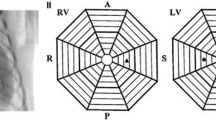Abstract
Modern pacemakers (implantable devices used for maintaining an appropriate heart rate in patients) can use an intracardiac ventricular impedance signal for physiological cardiac stimulation control. Intracardiac ventricular impedance from nine animal subjects is analysed and presented (seven sheep: 49.0±6.5 kg, sinus rhythm 100.3±16.5 beats min−1, average impedance 629.8±72.6Ω; and two dogs: 30 kg each, sinus rhythm 86.0 beats min−1, 862.1Ω and 134.0 beats min−1, 1114.6Ω, respectively). The averaged curve and standard deviation curve of the impedance in sinus rhythm were analysed in MATLAB to clarify and study consistent impedance shape over one heart cycle. In eight of nine (89%) animal subjects, a consistent impedance slope change (notch) was observed in the early stage of the cardiac filling phase. This result was reproduced in an additional subject with simultaneous echocardiographical measurements of mitral valve blood flow. The notch occured soon after rapid early filling (E-wave in mitral flow) but prior to ventricular filling caused by atrial contraction, indicating that the impedance notch was caused by rapid ventricular filling and that it might be a sensed feature of diagnostic value. The intracardiac impedance notch in the present study had similar features to the non-invasive transthoracic impedance O-wave reported by others, and it is shown here that an O-wave is found in intracardiac impedance signals, strongly suggesting that the non-invasive O-wave is caused by cardiac events.
Similar content being viewed by others
References
Alt, E., Combs, W., Willhaus, R., Condie, C., Bambl, E., Fotuhi, P., Pache, J, andSchomig, A. (1998): ‘A comparative study of activity and dual sensor: activity and minute ventilation pacing responses to ascending and descending stairs’,PACE,21, pp. 1862–1868
Baan, J., Van Der Velde, E. T., De Bruin, H. G., Smeenk, G. J., Koops, J., andVan Duk, A. D. (1984): Temmerman, D., Senden, J., Buis, B., ‘Continuous measurement of left ventricular volume in animals and humans by conductance catheter’,Circulation,70, pp. 821–823
Charles, R., Jones, B., andSpinelli, J. (1994): ‘Intracardiac Impedance as a rate limit-sensor’,PACE,17, 852
Chirife, R. (1991): ‘Sensor for right ventricular volumes using the trailing edge voltage of a pulse generator output’,PACE,141, pp. 1821–1827
Chirife, R., Ortega, D. F., andSalazar, A. I. (1993): ‘Feasibility of measuring relative right ventricular volumes and ejection fraction with implantable rhythm control devises’,PACE,16, pp. 1673–1683
Das, G., andCarlblom, D. (1990): ‘Artificial cardiac pacemakers (review)’,Int. J. Clin. Pharmacol. Ther. Toxicol.,28, pp 177–189
Foster, K. R., andSchwan, H. P. (1989): ‘Dielectric properties of tissues and biological materials: a critical review’,Crit. Rev. Biomed. Eng.,17, pp. 25–104
Gabriel, S., Lau, R. W., andGabriel, C. (1996): ‘The dielectric properties of biological tissues: III Parametric models for the dielectric spectrum of tissues’,Phys. Med Biol.,41, pp. 2271–2293
Hatle, L. (1986): ‘Introduction to Doppler echocardiography’,Acta Paediatr: Scand. Suppl. 329, pp. 7–9
Hatle, L. (1987): ‘Noninvasive measurements of intracardiac blood flow velocities with Doppler ultrasound (review)’,Acta Med. Scand.,221, pp. 133–136.
Hubbard, W. N., Fish, D. R., andMcBrien, D. J. (1986): ‘The use of impedance cardiography in heart failure’,Int. J. Cardiol.,12, pp. 71–79.
Karlöf, I. (1974): ‘Haemodynamic studies at rest and during exercise in patients treated with artificial pacemaker’,Acta Paediatr. Scand. Suppl.,565, pp. 1–24
Karnegis, J. N., andKubicek, W. G. (1970): ‘Physiological correlates of the cardiac thoracic impedance waveform’,Am. Heart. J.,79, pp. 519–523
Karnegis, J. N., Heinz, J., andKubicek, W. G. (1981): ‘Mitral regurgitation and characteristic changes in impedance cardiogram’,Br. Heart J.,45, pp. 542–548
Kauppinen, P. (1999): ‘Application of lead field theory in the analysis and development of impedance cardiography’. Ph.D. thesis,Tampere University of Technology, ISBN: 952-15-0297-5
Kelsey, R. M., andGuethlein, W. (1990): ‘An evaluation of the ensemble averaged impedance cardiogram’,Psychophysiology,27, pp. 24–33
Kubicek, W. G., Karnegis, J. N., Patterson, R. P., Witsoe, D. A., andMattson, R. H. (1966): ‘Development and evaluation of an impedance cardiac output system’,Aerosp. Med.,37, pp. 1208–1212
Kubicek, W. G., Kottke, J., Ramos, M. U., Patterson, R. P., Witsoe, D. A., Labree, J. W., Remole, W., Layman, T. E., Schoening, H., andGaramela, J. T. (1974): ‘The Minnesota impedance cardiograph-theory and applications’Biomed. Eng.,9, pp. 410–416
Lababidi, Z., Ehmke, D. A., Durnin, R. E., Leaverton, P. E., andLauer, R. M. (1970): ‘The first derivative thoracic impedance cardiogram’,Circulation,41:4, pp. 651–658
Lababidi, Z. (1978): ‘The O-point and diastolic impedance waveform’,Am. Heart J.,96, pp. 277–279
Lau, C. P. (1992): ‘The range of sensors and algorithms used in rate adaptive cardiac pacing (review)’,PACE,15, pp. 1177–1211
Muzi, M., Ebert, T. J., Tristani, F. E., Jeutter, D. C., Barney, J. A., andSmith, J. J. (1985): ‘Determination of cardiac output using ensembleaveraged impedance cardiograms’,J. Appl. Physiol.,58, pp. 200–250
Napholz, T., Lubin, M., andValenta, H. (1987): Metabolicdemand pacemaker and method of using the same to determine minute volume’. US Patent 4702253
Napholz, T., Hamilton, J., andHansen, J. (1990): ‘Minute volume rate-responsive pacemaker’. US Patent 4901725
Pickett, B. R., andBuell, J. C. (1993): ‘Usefulness of the impedance cardiogram to reflect left ventricular diastolic, function’,Am. J. Cardiol.,71, pp. 1099–1103
Prewitt, T., Gibson, D., Brown, D., andSutton, G. (1975): ‘The ‘rapid filling wave’ of the apex cardiogram. Its relation to echocardiographic and cineangiographic measurements of ventricular filling’,Br. Heart J.,37, pp. 1256–1262
Ramos, M. U. (1977): ‘An abnormal early diastolic impedance waveform: a predictor of poor prognosis in the cardiac patient?’,Am. Heart. J.,94, pp. 274–281
Rhoades, R., andTanner, G. (1995): ‘Medical physiology’ (Little Brown, 1995) ISBN 0-316-74228-7
Salo, R. W., Pederson, B. D., Olive, A. L., Lincoln, W. C., andWallner, T. G. (1984): ‘Continuous ventricular volume assessment for diagnosis and pacemaker control’,PACE,7, pp. 1267–1271
Schaldach, M., Ebner, E., Hutten, H., Von Knorre, G. H., Niederlag, W., Rentsch, W., Volkmann, H., Weber, D., andWunderlich, E. (1992): ‘Right ventricular conductance to establish closed-loop pacing’,Eur. Heart J.,13, pp. 104–112
Shoemaker, W. C., Wo, C. C., Bishop, M. H., Appel, P. L., Van De Water, J. M., Harrington, G. R., Wang, X., andPathl, R. S. (1994): ‘Multicenter trial of a new thoracic electrical bioimpedance device for cardiac output estimation’,Crit. Care. Med.,22, pp. 1907–1912
Spinelli, J. (1994): ‘Continuous hemodynamic evaluation of the maximum sensor rate’,Eur. J. Cardiac Pacing Electrophysiol.,2, 202
Stamato, T. M., Szwarc, R. S., andBenson, L. N. (1995): ‘Measurement of right ventricular volume by conductance catheter in closedchest pigs’,Am. J. Physiol.,29, pp. H869-H876
Woltjer, H. H., Bogaard, H. J., Bronzwaer, J. G., De Cock, C. C., andDe Vries, P. M. (1997): ‘Prediction of pulmonary capillary wedge pressure and assessment of stroke volume by noninvasive impedance cardiography’,Am. Heart J., 134, pp 450–455
Author information
Authors and Affiliations
Corresponding author
Rights and permissions
About this article
Cite this article
Järverud, K., Ollmar, S. & Brodin, L.Å. Analysis of the O-wave in acute right ventricular apex impedance measurements with a standard pacing lead in animals. Med. Biol. Eng. Comput. 40, 512–519 (2002). https://doi.org/10.1007/BF02345448
Received:
Accepted:
Issue Date:
DOI: https://doi.org/10.1007/BF02345448




